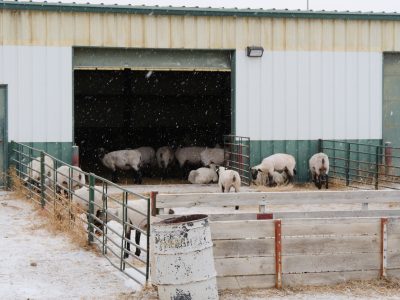January exited with a blast of arctic cold. About this time, many gestating ewes and cows entered the third trimester, marking the last phase of pregnancy in which the bulk of fetal growth occurs.
The energy demands of cold temperatures and pregnancy increase the nutritional requirements of ewes and cows, and this is especially true for yearling ewes or first calf heifers that are still making gains toward their mature body size.

The 2022 University of Wyoming Extension bulletin “Supplementation Considerations for Ewes Managed on Dormant Winter Pastures and Rangelands” contains an excellent overview of nutritional requirements of sheep during this period with critical environmental and physiological burdens. On the beef cattle side, see the 2015 University of Nebraska-Lincoln Extension bulletin “Supplementation Needs for Gestating and Lactating Beef Cows and Comparing the Prices of Supplement Sources.” Find these publications online at bit.ly/winter-ewe and bit.ly/winter-cow, respectively.
Supplementing with alfalfa, distillers grains, or range cake supplies rumen degradable protein (RDP), formerly known as degradable intake protein (DIP). This protein boosts the rumen microbes that break down low quality forages and helps the animal access energy that would otherwise be locked up in cellulose.
When forage is low in quality, as it often is during winter and after drought, it can become physically impossible for animals to consume enough to meet their energy or protein needs—they simply run out of space in their digestive systems. The growing fetus and expanding uterus further restrict the rumen and capacity for feed intake. Without proper management, the animal can go into a negative energy balance and begin to metabolize stored energy in the form of body fat reserves. This puts the body into a state of ketosis.
If sustained for long periods, ketosis can develop into the metabolic disease known commonly as pregnancy toxemia. This is not the result of a calcium deficiency, as in milk fever, or a deficiency of magnesium, as in tetany, although these diseases should be ruled out when you consult with your veterinarian.
Pregnancy toxemia is most likely to present late in gestation in sheep and goats carrying multiple offspring or in obese individuals, due to the spatial restrictions imposed on the rumen. Less frequently observed in cattle, pregnancy toxemia is most likely at or near peak lactation in high milking capacity individuals fed poor quality diets that similarly enter a negative energy balance.
Common symptoms of pregnancy toxemia include an animal going off feed and showing lethargic behaviors, progressing to recumbency and death in severe cases. Neurological signs such as head pressing or circling may also occur as a result of ketone buildup in the blood.
As ranchers make their daily animal checks, they should look closely for any individuals that appear depressed and “out of it.” Are they tracking movement? Are their ears up and eyes bright? Are they keeping their heads up as the rancher approaches? Are they up and eating at feeding time? These are routine livestock husbandry observations, but catching any problem animals early can lead to the best outcomes.
If pregnancy toxemia is suspected, work with a veterinarian to develop a treatment plan. Since the cause is a deficit in available energy, supplementation with rapidly available glucose is often the simplest and least invasive therapy. Many over the counter oral drenches are available to counter the effects of ketosis, but be sure that the product you have is labeled for use in the correct species. Something that is labeled for use in cattle may not be labeled for use in sheep and vice versa. In extreme cases, a veterinarian can administer an intravenous glucose infusion. Watch affected animals closely for secondary infection during recovery from pregnancy toxemia.
While treatments are available, it is best to prevent pregnancy toxemia/ketosis from occurring in the first place. Ensure that animals consume a high quality, balanced diet and have access to clean water from late gestation to peak lactation. Use body condition scoring to maintain breeding females in moderate flesh (BCS 3-4 for sheep, BCS 5-6 for cattle), avoiding both the thin and obese extremes of the scale. Utilize grain or concentrate supplements as appropriate, especially to provide sufficient protein when grazing dormant winter range, as animals enter the third trimester of gestation (days 100–150 of gestation for sheep, months 7–9 for cattle), or to counter the effects of severe winter weather events.
For the rancher, nutritional management is one of the most powerful tools to prevent disease and enhance productivity. Work with your local UW Extension educator if you have questions about your winter livestock rations.
Micah Most is the agriculture and natural resources educator with University of Wyoming Extension serving Johnson County. He can be reached at mmost@uwyo.edu, at (307) 684-7522 or on social media @ UW Extension Johnson County.




